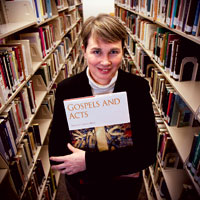 |
|
Spring 2007 | Volume 30, Number 1
| Features
|
|
|
"Multifaceted" continued

Susan Gallagher: "Form and technique imbue the text with meaning." |
The Bible as Literature
By Susan VanZanten Gallagher, Professor of English and Director of
the Center for Scholarship and Faculty Development
Regardless of their personal religious beliefs, most scholars
recognize the remarkable literary achievement of the Bible, arguably the single most influential piece of literature in the world.
Yet Christians sometimes pay scant attention to the Bible’s literary dimensions, not recognizing the ways in which form and technique imbue the text with meaning. Reading the Scripture without considering its literary qualities produces a blurred vision lacking the sharp, deep colors of truth.
The holy God graciously communicates with humanity in our “language”: most notably in the Word made flesh in Jesus Christ, but also through Hebrew and Greek and English. In the special revelation recorded in Scripture, God’s human-sensitive method of communication involves speaking through a variety of literary genres. In constructing the Canon, the church deliberately embraced this plenitude, providing multiple limited perspectives on the limitless mysteries of God’s story.
The opulent anthology of the Bible includes apocalyptic visions, folk tales, genealogies, historical narratives, laws, letters, liturgical songs, lyric poetry, orations, parables, prophecies, proverbs, sermons, and wisdom literature. Identifying genre and its tone prevents misinterpretations and facilitates deeper discernment: A parable, for instance, should not be read as a historical narrative; a lyric poem cannot be read effectively with the same interpretive strategies as an oration. When Paul is being sarcastic, we will mistake the message if we miss his tone. The disciples were notoriously tone-deaf at times in listening to Jesus, who occasionally had to steer them in the right direction (John 4:31–34). Learning about the parallelism of Hebrew poetry, or the metonymy of ancient genealogies, or the ring-structure of folk tales, or the symbolism of visionary literature will facilitate richer readings.
Besides becoming sensitive to genre, our reading of the Bible will deepen with attention to three central literary qualities:
metaphor, order, and intertextuality.
One of the most fundamental ways in which we understand anything in language is through metaphor: describing something by comparing it with another thing. When we use metaphor, we say that one thing is another: “The Lord is my shepherd.” In metaphor, we do not so much create a one-to-one correspondence between two concepts as set up an interaction between them. We take the word shepherd from its original context in agrarian Jewish society and use it to ponder a different, less familiar concept: the character of God. Our recognition of similarities makes the unknown more familiar. But the audacity of the comparison, the dissonances in the concepts — the holy Yahweh and the humble shepherd — also generates discovery through tension.
Metaphors generate meaning in waves of associated possibilities. In Psalm 23, the poet enacts this process for us, progressing through different shepherd functions — feeding, sheltering, protecting, guiding — to help us see anew some ways in which God interacts with us. Unpacking metaphors and reflecting upon the resonances that they create dynamically expand our scriptural encounters.
The order in which events are recounted or ideas are presented is a second fundamental literary technique. Psalm 23 appropriately concludes with “dwelling in the house of the Lord forever” rather than stating that idea in, say, verse 3. Walking through “the valley of the shadow of death” and encountering evil come in the dead center of the poem. And the grass and water supplied to the sheep in verse 2 are mirrored in the more human table and cup of verse 5. Such careful ordering pervades biblical poetry and prose alike. In prose, the order and appearance of dialogue as opposed to narration are crucial. Noticing when events are conveyed through dialogue and when they are directly described by the narrator gives insight into characterization, motivation, and moral judgments.
Finally, one of the richest dimensions of biblical literature lies in its intertextuality — direct quotations, subtle allusions, and muted echoes of other scriptural passages. In Mark 6:34, when Jesus is interrupted in a much-needed desert retreat by thousands of admirers, he has compassion because the people “were as a sheep not having a shepherd.” The faint echo of Psalm 23 becomes louder in the next scene when Jesus provides an abundant table from a mere five loaves and two fishes.
While single passages grow in intellectual, emotional, and spiritual significance when we consider their literary aspects, the remarkable intertextuality of the Bible relies on repeated reading of the entire canon. Such readings also reveal the overarching narrative of creation, fall, redemption, anticipation, and full revelation of the kingdom. Reading the Bible as literature entails both sensitivity to literary genres and techniques, and recognition of repeated motifs and the grand story.
Back to Story | Next Page 2 of 5
Back to the top
Back to Features Home
|
| |
|
 |
 |

|
 |
from the president
Embracing the Christian Story
SPU President Philip Eaton asks what would happen if the Bible were at the center of the learning enterprise.
campus
Destination: Asia
SPU President Philip Eaton joined a historic delegation of U.S. university presidents that visited Asia.
alumni
Coffee as Change Agent?
Pura Vida employees, including several SPU alumni, engage the culture using a social-venture business model.
books, film, & music
Dark Alphabet
Jennifer Maier, poet and SPU associate professor of English, receives a literary award for her first book.
athletics
National Tournament Returns
For the first time in 10 years, SPU hosts the USA Gymnastics Women's Collegiate Championship.
my response
Undone by the Word
Response writer Kathy Henning shares her journey to know the Bible better.
Response art
Pink Emperors
Class of 1973 alumna Jill Ingram introduces Response readers to “Pink Emperors.”
|
 |
|
 |